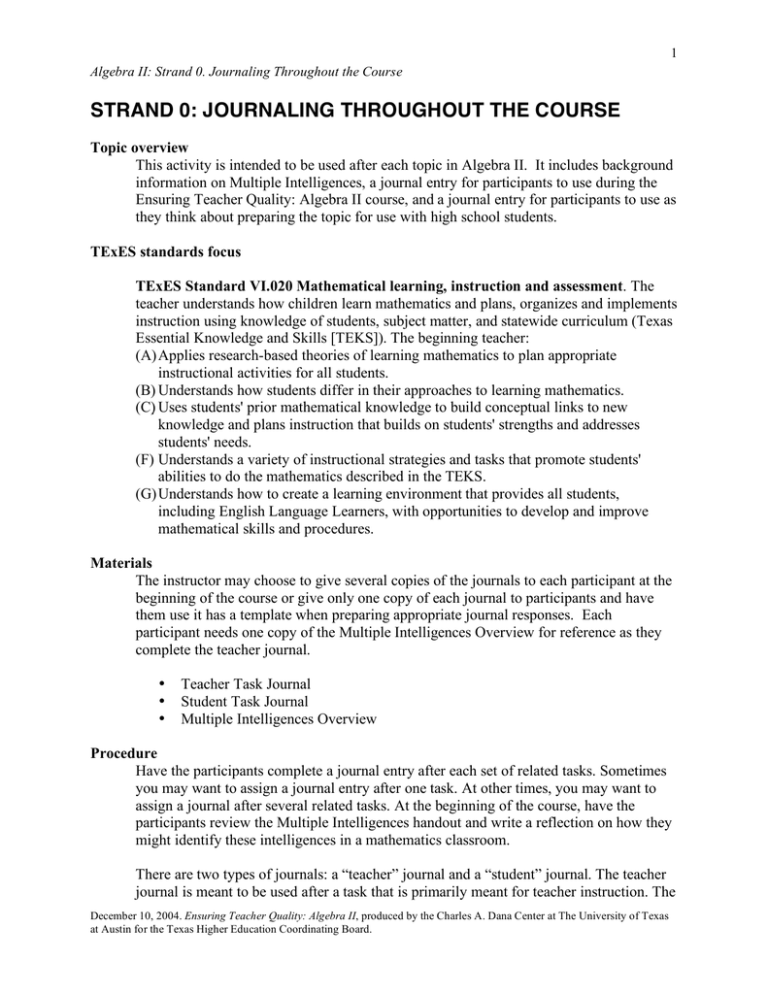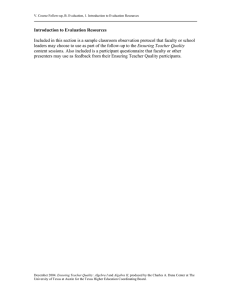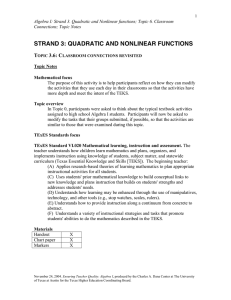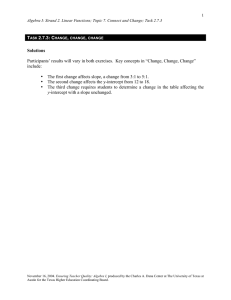STRAND 0: JOURNALING THROUGHOUT THE COURSE
advertisement

1 Algebra II: Strand 0. Journaling Throughout the Course STRAND 0: JOURNALING THROUGHOUT THE COURSE Topic overview This activity is intended to be used after each topic in Algebra II. It includes background information on Multiple Intelligences, a journal entry for participants to use during the Ensuring Teacher Quality: Algebra II course, and a journal entry for participants to use as they think about preparing the topic for use with high school students. TExES standards focus TExES Standard VI.020 Mathematical learning, instruction and assessment. The teacher understands how children learn mathematics and plans, organizes and implements instruction using knowledge of students, subject matter, and statewide curriculum (Texas Essential Knowledge and Skills [TEKS]). The beginning teacher: (A) Applies research-based theories of learning mathematics to plan appropriate instructional activities for all students. (B) Understands how students differ in their approaches to learning mathematics. (C) Uses students' prior mathematical knowledge to build conceptual links to new knowledge and plans instruction that builds on students' strengths and addresses students' needs. (F) Understands a variety of instructional strategies and tasks that promote students' abilities to do the mathematics described in the TEKS. (G) Understands how to create a learning environment that provides all students, including English Language Learners, with opportunities to develop and improve mathematical skills and procedures. Materials The instructor may choose to give several copies of the journals to each participant at the beginning of the course or give only one copy of each journal to participants and have them use it has a template when preparing appropriate journal responses. Each participant needs one copy of the Multiple Intelligences Overview for reference as they complete the teacher journal. • • • Teacher Task Journal Student Task Journal Multiple Intelligences Overview Procedure Have the participants complete a journal entry after each set of related tasks. Sometimes you may want to assign a journal entry after one task. At other times, you may want to assign a journal after several related tasks. At the beginning of the course, have the participants review the Multiple Intelligences handout and write a reflection on how they might identify these intelligences in a mathematics classroom. There are two types of journals: a “teacher” journal and a “student” journal. The teacher journal is meant to be used after a task that is primarily meant for teacher instruction. The December 10, 2004. Ensuring Teacher Quality: Algebra II, produced by the Charles A. Dana Center at The University of Texas at Austin for the Texas Higher Education Coordinating Board. 2 Algebra II: Strand 0. Journaling Throughout the Course student journal is meant to be used after tasks that are student ready or only require limited modifications to make them student ready. Both types of journals require participants to connect the TEKS and TAKS objectives related to the task. It is not necessary that the participant answer every question on a journal. The questions are designed to encourage reflective thinking. Participants may even have comments of their own that are not directly asked by the journals. They important thing is that the participants take time to think about the tasks and how the tasks relate to their own mathematical and pedagogical knowledge development as well as their students’ mathematical development. The journals may be discussed in large or small groups. They do not necessarily all have to be collected and read by the instructor. You may want to have the participants submit them all at the end of the course as a complete body of reflective writing. December 10, 2004. Ensuring Teacher Quality: Algebra II, produced by the Charles A. Dana Center at The University of Texas at Austin for the Texas Higher Education Coordinating Board. 3 Algebra II: Strand 0. Journaling Throughout the Course Journal Entry for the Ensuring Teacher Quality: Algebra II Course Name of Topic __________________________ Focus on the TEKS: 1. What mathematics were addressed in the tasks? List both skills and concepts. 2. In what ways, if any, does this task relate to the TAKS objectives? 3. How is the content for teaching the Algebra II TEKS reinforced or extended? 4. What prior knowledge is required for the tasks? 5. What mathematical concepts would you like to have reviewed before doing this task? 6. I am still unclear about the following concepts: 7. These tasks helped me think differently about… 8. In the classroom I will focus more/less on… December 10, 2004. Ensuring Teacher Quality: Algebra II, produced by the Charles A. Dana Center at The University of Texas at Austin for the Texas Higher Education Coordinating Board. 4 Algebra II: Strand 0. Journaling Throughout the Course Journal Entry for Preparing the Topic to Use with Students Name of Topic ________________________ Focus on the TEKS: 1. What Algebra II TEKS were introduced, reinforced, or extended in the tasks? 2. How do these tasks support subsequent courses? 3. Which multiple intelligences were addressed in this task? o o o o o o o o Linguistic (word sensitive) Logical-mathematical (number/reasoning sensitive) Spatial (picture sensitive) Body-Kinesthetic (body sensitive) Musical (music sensitive) Intrapersonal (self sensitive) Interpersonal (people sensitive) Naturalistic (nature sensitive) 4. Can you take this task to the classroom: If so, how would you adapt it? Or, how would you adapt this task to address one of the multiple intelligences not addressed above? 5. How can this task be modified to support the struggling student or the ESL student? How could the task be extended to challenge the pre-AP student? 6. I will use this task when I am teaching_____________ December 10, 2004. Ensuring Teacher Quality: Algebra II, produced by the Charles A. Dana Center at The University of Texas at Austin for the Texas Higher Education Coordinating Board. 5 Algebra II: Strand 0. Journaling Throughout the Course Multiple intelligences Howard Gardner, a professor of education at Harvard University, developed the theory of multiple intelligences. The theory states that we all have eight intelligences. The extent to which each intelligence is developed in an individual varies considerably. Gardner defines intelligence as “the capacity to solve problems or to produce products that are valued in one or more culture.” (Gardner, 2000) Types of Intelligences • Verbal-Linguistic – highly developed verbal skills; sensitivity to word sounds, meanings and rhythms • Mathematical-Logical – the ability to use numbers and patterns; reasons well and thinks abstractly • Musical – ability to appreciate and produce music, rhythm and pitch. • Visual Spatial – ability to think in terms of images; to graphically represent visual or spatial concepts • Body-Kinesthetic – has the ability to control one’s own body; can use one’s hands to produce or transform things • Intrapersonal – is aware of one’s self, ones emotions, values, and beliefs • Interpersonal – ability to detect and respond the emotions and motivations of others • Naturalist – sensitivity to plants, animals and other natural objects; is attuned to one’s environment, be it natural or urban Thomas Armstrong (2000) suggests the following questions to help teachers in planning lessons for multiple intelligences: • Verbal-Linguistic – How can I use the spoken or written word? • Mathematical-Logical – How can I bring in numbers, calculations, logic, classifications, or critical thinking skills? • Musical – How can I bring in music or environmental sounds, or set key points in a rhythmic or melodic framework? • Visual Spatial – How can I use visual aids, visualization, color, art, or metaphor? • Body-Kinesthetic – How can I involve the whole body or use hands-on experiences? • Intrapersonal – How can I evoke personal feelings or memories, or give students choices? • Interpersonal – How can I engage students in peer sharing, cooperative learning, or large group simulation? • Naturalist – How can I incorporate living things, natural phenomena, or ecological awareness? For further reading Armstrong, T. (2000). Multiple intelligences in the classroom. Association for Supervision and Curriculum Development: Alexandria, Virginia. Gardner, H (2000). Intelligence reframed: multiple intelligences for the 21st century. New York: Basic. On the web: ERIC Digest. “Multiple Intelligences: Gardner's Theory.” [Online] 26 April 2004. <http://http://www.ericfacility.net/ericdigests/ed410226.html>. December 10, 2004. Ensuring Teacher Quality: Algebra II, produced by the Charles A. Dana Center at The University of Texas at Austin for the Texas Higher Education Coordinating Board.


